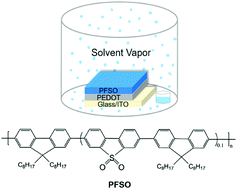Modifying the organic/metal interface via solvent vapor annealing to enhance the performance of blue OLEDs†
Abstract
Modifying the organic/metal interface has become an efficient way to improve the performance of organic electronic devices. Compared to direct solvent application to organic functional layers, solvent vapor annealing (SVA) is a scalable process which is easier to manage by controlling the annealing time, and offers a wider choice of solvents. Though SVA has been explored, solvent vapor was used to re-dissolve the functional layer to induce a morphology change. In our contribution, we introduce an interfacial dipole layer at the organic/metal interface by a solvent with strong polarity while keeping the functional layer intact. By treating the blue light-emitting polymer poly[(dibenzo-thiophene-S,S-dioxide)-co-(dioctyl-2,7-fluorene)] (PFSO) with methanol vapor for 90 min, the luminous efficiency increases from 3.8 cd A−1 to 6.0 cd A−1, while the turn-on voltage is reduced from 3.4 V to 2.8 V. It's discovered that the interface dipole between the cathode and the emission layer is responsible for the performance enhancement. The interface dipole identified by ultraviolet photoelectron spectroscopy (UPS) and Kelvin Probe Force Microscopy (KPFM) improves the electron injection by lowering the electron injection barrier. When the hole current and the electron current are balanced inside the device, the maximum efficiency is reached. Extending the vapor annealing time will result in excessive electrons, breaking the hole–electron balance. As a result, the efficiency decreases.



 Please wait while we load your content...
Please wait while we load your content...